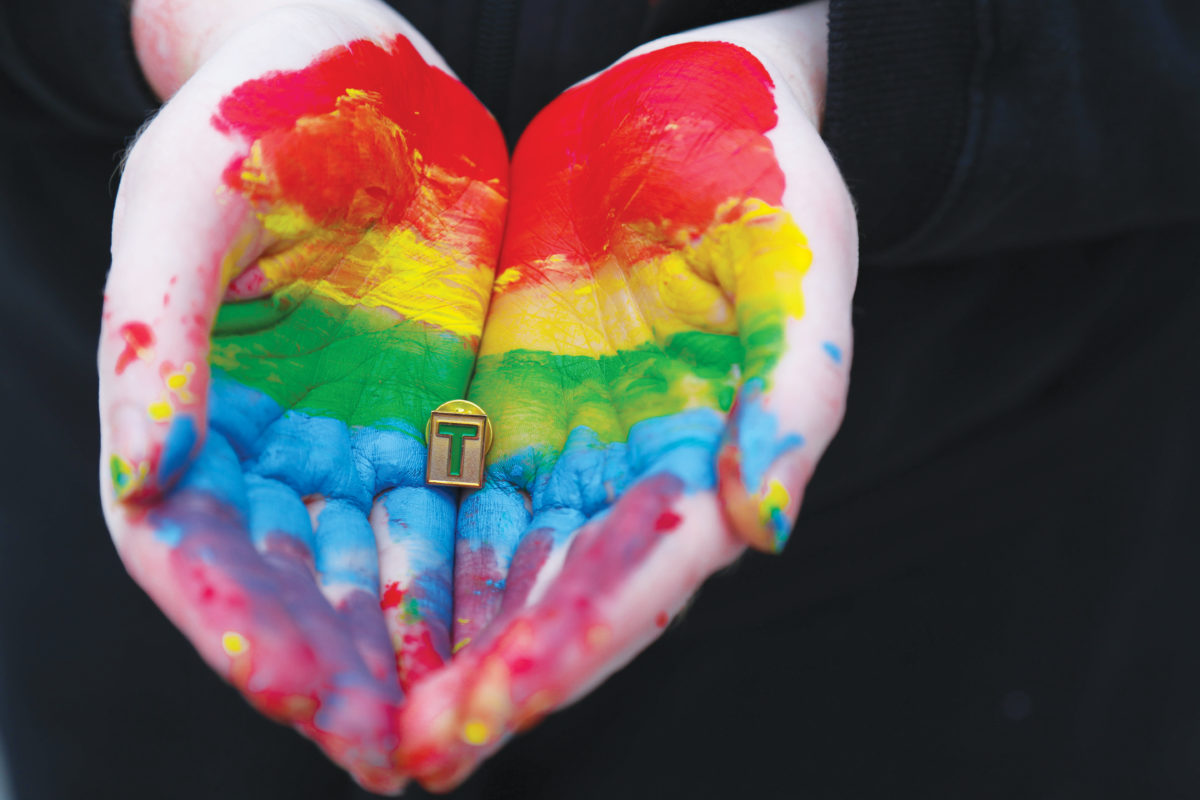My girlfriend and I are cuddling on my bed and we are talking. We are speaking about why and what we love about each other. I make a comment about loving her as a woman and her smile quickly falls, replaced by a worried frown and she bites her lip. I ask her what’s wrong, wondering what I have said. She looks at me and says in a choked tone, “What if I don’t think I’m a woman?”

Now, she goes by the name Eli and identifies by the pronoun they rather than he or she; they are genderqueer. Eli is one of several St. Thomas students who fall outside of the social construct of gender.
I wanted to understand how being a transgender student affects a person’s life at STU and why they came here in the first place.
***
I first speak with my friends Al and Cas at supper in the meal hall. We sit at one of the high round tables where the snow outside the window is taller than us. They are both first-year students: Al lives in Rigby and Cas in Vanier. Al identifies as non-binary or genderqueer and Cas identifies as genderqueer. They both prefer to go by they pronouns.
Non-binary is a term used by people who identify their gender as something outside of man or woman. Genderqueer is similar but covers gender identity and gender expression. People will also use the term if they do not want to be specific about their gender. They pronouns are neutral terms that a person may choose to use so as not to be segregated into a gender (man or woman) that they do not identify with.
I ask them about their first week at STU. Al pipes in: “Well you know that I was running to Rigby to pee for the first week.” They were doing this because they did not yet know where the gender-neutral bathrooms were on campus.
They tell me about the trouble of not presenting as male or female.
“There’s a lot of misgendering and eventually it gets to a point where it’s like I can’t correct everyone,” explains Cas. Cas has found it difficult living in Vanier where the emphasis on “Vanier Ladies” is so strong. Though it is difficult on Cas and Al to have their gender misidentified, they rarely speak up.
“It’s hard to confront people about your gender because it’s a vulnerability,” says Al.
Still, they say there’s a welcoming culture on campus.
“I was floored the first time someone came up to me and asked me [by] my pronouns”, says Al. “STU seems to have this deep compassion and students seem to have this interest in other peoples experiences that I don’t think is something that sets it apart from high schools, I think that that’s something that sets it apart from universities.”
Al talks about their work with Student Services this year. Al has been working to make residence life at STU more accommodating and welcoming to transgender people. Gender-neutral housing is one option being considered.
***
My biggest concern with Eli identifying as genderqueer was their happiness and I wanted to do everything I could to help them better understand themselves. During Christmas break I was in Halifax and stopped by Venus Envy, a LGBTQ+ friendly bookstore and sex shop, to get them a chest binder. They tried on all their clothes with it on to see how it looked and sent me lots of selfies.
My favourite moments are when I call them by the name Eli. They light up, especially their eyes, and they hug me, burying their head into my chest like a shy child.
***
Later that evening, Eli and Harper meet in my room to chat. Both of them have streaks of colour in their bangs. We sit on the bed, Eli on my left and Harper on my right.
I ask them about their gender identity. Eli has recently identified as genderqueer or non-binary, while Harper tells me they are bi-gender. This means that they identify with two genders, in their case, male and female.
“I’m walking around with two names,” says Harper. “So I think I’m used to being called Harper at school and stuff and by prof’s and by my other family and then I come home and it’s Liz and Lizzy and Elizabeth.”
Transgender people can feel like spies walking around with several identities.
This is a common experience in class. The attendance list has student’s legal names rather than preferred names. When this happens transgender students must decide what identity they will go by in that class.
“It’s a sensitive subject for some people and they’re going to be hesitant to bring that up unless they’re given the opportunity,” says Eli.
They talk about the stigma of not being trans enough.
“There’s some people who also believe that if you don’t have dysphoria (discomfort) in your own body then you’re not trans,” says Eli. Harper tells me about going to a transgender support group meeting and feeling as though they did not present as “queer” enough to fit in.
***
For Al and Harper St. Thomas’ openness and concern for the well-being of transgender students was a core part of their decision to come to Fredericton. For the first time people don’t always assume their gender and the university’s administration and staff are working to improve the lives of transgender students.
When asked how much it affected their choice, Harper said: “100 per cent! I got accepted to UNB for psych and stuff but I was like ‘no I’m going to STU.’”